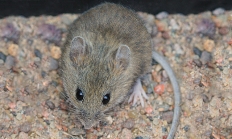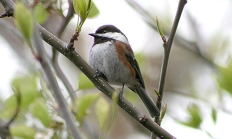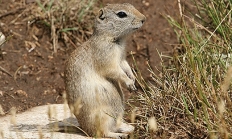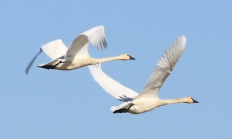Search myodfw.com
The brush rabbit rarely ventures more than a few meters from the extremely dense brush that constitutes the requisite component of their habitat. Runways are interlaced through brushy clumps into surrounding grassy areas and are kept clear of vegetation for easy and quick access to and from foraging areas. In Oregon, the brush rabbit occurs in the Willamette Valley and other interior valleys, in coastal areas, and in valleys along coastal streams from the Columbia River south, and from the foothills of the Cascade Range west. Photo by ©Keith Kohl, ODFW

The Western harvest mouse is the smallest sigmodontine rodent in Oregon. It occurs east of the Cascade Range, except it is absent from the Blue and Wallowa mountains; it also occurs in the southern parts of Josephine and Jackson counties west of the Cascades. The Western harvest mouse commonly uses runways. It is active nocturnally with its greatest activity between sunset and sunrise. They spend periods of inactivity in ball-shaped nests constructed on the surface of the ground; nests are sometimes placed beneath shrubs or debris. Photo by J. N. Stuart, Flickr

The moose is the largest member of the family Cervidae. The pelage is blackish or dark brownish grading to dark gray or grayish brown on the venter and leg. The muzzle is broad and overhanging, the palmate antlers of adult males are massive, and a "bell" (waddlelike flap of skin on the throat) is present. The first moose to come to Oregon wandered south from Washington or west from Idaho across the Palouse Prairie. They stayed to establish a herd in the Blue Mountains north of Elgin, and today there are an estimated 50 adults and calves in the area

Western pond turtles prefer marshes, streams, rivers, ponds and lakes. They need sparse vegetation nearby for digging nests and like to bask on logs. Population declines are due to habitat loss, degradation of nesting areas by invasive plants, competition from non-native turtles and disease. Predators include raccoons and invasive bullfrogs and fish. Western pond turtles are Oregon Conservation Strategy Species in the Coast Range, East and West Cascades, Klamath Mountains and Willamette Valley ecoregions. Photo by Simon Wray, ODFW

Popularly called "Gooneybird" for its elaborate mating antics and clumsy takeoffs and landings and breeding islands, this is a large, spectacular seabird. Though small for an albatross, it glides on wind currents just above the ocean waves on long narrow wings which span approximately six-and-a-half feet. The dark gray wings, back and tail contrast with a white body and upper tail coverts. Singles or small groups are reported occasionally on offshore Oregon birding trips, primarily in winter. Hear the call of the Laysan albatross Photo by ©Greg Gilson

The Dunlin undergoes one of the most dramatic changes in appearance of all shorebirds when it molts from winter to breeding plumage. In winter, these medium sized sandpipers are brownish gray above with white underparts, but in breeding plumage they have a striking rufous-brown back and cap and black belly. Females are larger than males but otherwise similar in appearance. The Dunlin is an abundant transient and winter visitant in estuaries and occasionally on beaches along the coast of Oregon, but significant numbers winter in the Willamette Valley, especially the southern part. Hear the call of the Dunlin Photo by

Graceful and tern-like in many of its actions, this striking little gull displays flashing white outer primaries that contrast with a gray back. The Bonaparte's gull is an abundant spring and fall transient along the coast, primarily over the ocean just offshore and is fairly common and widespread elsewhere in Oregon, usually in flocks of less than 100. Larger flocks of up to 1,000 have occurred at Fern Ridge Reservoir in Lane County, during extreme storm conditions, and in the Klamath Basin. Hear the call of the Bonaparte's gull Photo by Martyne Reesman, ODFW

These, the most numerous jaegers off Oregon, are slightly smaller than Herring gulls. Gull-like and graceful, these piratical birds steal food from smaller seabirds. They come in a bewildering array of light and dark individuals, confounded by age and sexual differences. The Pomarine jaeger is an uncommon spring and fairly common fall transient offshore two to 50 miles, following shearwaters. Sightings have been centered near the continental shelf edge. They are occasionally observed from shore in fall. Hear the call of the Pomarine jaeger Photo by Martyne Reesman, ODFW

The only sapsucker regularly found in western Oregon, the Red-breasted sapsucker, with its raspberry-red head and breast, is unmistakable. It is found in moist coniferous coastal forest and mixed deciduous-coniferous coastal forest west of the Cascade crest, and in aspen-ponderosa pine forests east of the Cascades. Nest cavities are typically in large snags or live trees with decayed interiors. It is a fairly common breeder in the northern part of the state from the coast to the Cascades and south to the southern Cascades. Hear the call of the Red-breasted sapsucker Photo by Darla Marie Prater

This is one of the most audacious of Oregon's resident avifauna both in appearance and behavior. Its black coat and streaming tail dappled in blue-green iridescence contrasts starkly with its flashing white wing feathers during flight. Common and conspicuous east of the Cascades, the magpie prefers open areas stippled with dense thickets or trees. They are highly social, often gathering in large flocks. Historically despised and persecuted by hunters, farmers, and ranchers, this trickster has flourished in the tradition of the coyote. Hear the call of the Black-billed magpie Photo by Kathy Munsel, ODFW

Chestnut-backed chickadees are one of the most common species of bird in conifer forests of western Oregon. They are distinguished from other chickadees by their chestnut-colored back, lack of an eye-line, and their wheezy song. Like other chickadees, they are frequently observed performing acrobatic maneuvers such as hanging from branch tips while foraging high in the canopy. They also frequent bird feeders for suet and sunflower seeds, and will nest in boxes if they are placed near groves of conifers. Hear the call of the Chestnut-backed chickadee Photo by Kathy Munsel, ODFW

The California towhee can be found in chaparral habitats of southern Oregon, quietly flitting in and out of the brush in search of seeds. It is a plain brown bird with a rusty throat patch and undertail coverts. It is noticeably larger than the Spotted towhee. Its long slender tail is also a useful identifying feature. Sexes cannot be told apart in the field, but juveniles can be distinguished by the extensive streaking and spotting of the underparts. The California towhee is a fairly common permanent resident throughout the Rogue, Applegate, and Illinois Valleys. Hear the song of the California

The buzzy, insect-like song of the Savannah sparrow is a characteristic sound of open landscapes dominated by grasslands throughout Oregon. Savannah sparrows are usually heard or seen when perched atop a fence post, small shrub, or tall weed, or running on the ground between openings in vegetation until the bird abruptly drops down into cover. The Savannah sparrow nests on the ground, often in a slight depression and well concealed by a canopy of dead vegetation or partially tucked under a clump of vegetation. Hear the song of the Savannah sparrow Photo by Dave Budeau, ODFW

The Swamp sparrow uses wet areas that have thick vegetation for cover. Several glimpses of this reclusive bird may be required before it can safely be separated from Lincoln's sparrow or the more common Song sparrow, though its distinctive call will give it away to observers familiar with it. Chestnut coloration on the wing coverts helps separate this species from other wintering sparrows. The Swamp swallow is a rare to uncommon spring and fall transient and winter visitant in western Oregon, especially along the coast. Hear the song of the Swamp sparrow Photo from USFWS

This species breeds from northeast British Columbia to Nova Scotia and south to north Georgia. It winters in Middle and South America. Small numbers regularly occur along the west coast, especially in spring. The majority of Oregon records have occurred from early March through July, mostly from mid-May to mid-June. Individuals are occasionally found from mid-September to mid-January, mostly birds that remained less than five days. Here the song of the Rose-breasted grosbeak Photo by Anna Hesser, Flickr

For many, the rich, melodious song of the Black-headed grosbeak is the music of springtime in Oregon. The handsome males, with their bold pattern of cinnamon, black, and white, are among our most striking songbirds, and area familiar site in parks and gardens as well as in almost every forest type in the state. The buffy, streaked females are less conspicuous, but are also accomplished singers. The Black-headed grosbeak is a common to fairly common breeder and common migrant in forested regions throughout the state. Hear the song of the Black-headed grosbeak Photo by David Bronson

The Wyoming ground squirrel is a medium-sized ground squirrel without spots, stripes, or splotches. The dorsal pelage is grayish with a slight buffy wash. In the field, it appears distinctly more yellowish than other ground squirrels that it might be confused with. The tail is usually longer, as well. This ground squirrel is found in southeastern Oregon and emerges from hibernacula in the spring and by late July has again entered torpor. During the active season, individuals usually become active within an hour after sunrise. Photo by Andrew Hoffman, Flickr

The Western gray squirrel is the largest tree squirrel in the state. It occurs from central Wasco, Jefferson, Deschutes, and Klamath counties west, except for unforested portions of the Willamette Valley, to central Washington, Benton, Lane, Douglas, Coos, and Curry counties. It is commonly associated with mixed forest communities. These squirrels are wary and secretive, but curious; they examine new objects placed in their environment but, once captured, they often avoid live traps. Western gray squirrels are an Oregon Conservation Strategy Species in the Willamette Valley ecoregion. Photo from ODFW

Features: Opah are also known as moonfish due to their round, laterally compressed bodies. These fish are very beautiful with pale red colored and lighter spots throughout resembling the craters on the moon, and orange-red fins. Opah grow to an average of 3-feet long and 100 pounds. Habitat: Opah can be found in temperate and tropical waters. They tend to be at depths of 300- to 1,000-feet during the day and come above 300-feet at night. Technique: These fish are rare in Oregon's waters and are difficult to catch by rod and reel, though they are occasionally brought in.

Of several swans found in Oregon, the tundra swan is by far the most common during the non-breeding season. It is most readily distinguished from the similar-appearing trumpeter swan by voice, although subtle differences in physical appearance and behavior can separate the two with difficulty. It is a fairly common transient throughout the state but most abundant at large bodies of water and wetland complexes east of the Cascades including the Malheur National Wildlife Refuge and the surrounding Harney Basin, Summer Lake Wildlife Area and the Klamath Basin. Hear the call of the tundra swan Photo by Kathy Munsel, ODFW

